Did you know that GenZ and Millennials are 99% more likely to choose a restaurant based on social media and reviews?
Yes, it can be a bit scary.
But it's also an excellent opportunity for your business!
Social media marketing can help you spread brand awareness, attract potential customers (foodies), and increase the number of bookings.
But, with over 660,000 restaurants operating in the U.S. alone, you might be questioning how you can stand out. We know that restaurant promotion on social media is not an easy task. However, you shouldn't despair because we've got your back.
In our guide to restaurant social media marketing, we'll cover everything you need to know to get started:
- Why should restaurants use social media
- What makes a great restaurant social media post
- 6 social media marketing tips to promote your restaurant
- Which social media platform should you use for your restaurant
Why should restaurants use social media?
Before we jump in with our feet first and hit the "schedule" button on your latest tweet, let's cover the basics and understand why your restaurant marketing strategy should include social media:
- Allows your restaurant to be found online
- Provides information and adds professionalism
- Opens two-way communication with your audience
- Targets local people and tourists
- Free promotion
1. Allows your restaurant to be found online
Establishing your social media presence is beneficial for multiple reasons. One of them is the simple fact that your potential guests can find you online.
So, why doesn't having a website or Google Maps location suffice?
According to Social Media Today, 30% of millennial diners actively avoid restaurants with a weak Instagram presence, and 59% say they often review menus online.
Nowadays, not having social channels makes your business invisible to the guests who would promote your restaurant for free. But we'll get to this a bit later.
2. Provides information and adds professionalism
Creating a social media content calendar for your restaurant is not just about including pretty pictures. Content on these channels is your chance to promote relevant information such as:
- Contact number to make a booking
- Location
- New additions to the menu
- Events
- Special offers on holidays
- Awards and recognitions
This adds to the overall sense of professionalism and care to provide your guests with the best experience. And in today's culture, this experience does not start in your restaurant but your social media channel.
Use our free and interactive holiday calendar to plan your special offers.
3. Opens two-way communication with your audience
Customer loyalty depends heavily on your services inside and outside of your restaurant. And one of the best places to nurture this loyalty is on your social media profile.
Community management plays a big part in creating a relationship with your potential and new guests. Use the comment section and direct messages to initiate conversations, answer their questions, and respond with love to their affection towards your unique dishes! This will help you attract new diners and find out about the food and services that excite them the most.
4. Target local people and tourists
Think about it: How many social media platforms do you use to find local eateries? For me, X (Twitter), Instagram, and Facebook fall into that list. If a brand isn't active on either of them, I won't find them - nor visit their restaurant.
Your (local) target audience might be the same. So add your location information in the bio and social media posts.
But don't stop there. Set aside some budget to launch some Facebook ad campaigns that target tourists!
One-third of travellers in the States turn to social media to find inspiration for their vacation. Why not target these people, and encourage them to come through your doors?
5. Free promotion
Social media is more affordable than offline advertising. Most of the time, it's completely free! The costs for billboard, radio or TV ads can quickly rack up, but you're likely to see a better return on your time invested in social media channels.
Adding the location to your posts and stories plays a big part, but so do relevant hashtags! And both of these are also free!
Not to mention that 69% of millennials take a photo of their food before eating it. And most of those photos end up in various formats on social media platforms. Pay close attention to these, and make sure to respond to them!
What makes a great restaurant social media post?
The first thing you need to remember is: A perfect social media post does not exist.
But you can make a pretty great one!
When it comes to food marketing, the quality of your visual content must be top-notch.
Make sure all of your posts have:
- Clear branding
- Engaging copy
- Relevant hashtags
- Call to action
Wondering how to do all of this and perfect restaurant social media marketing? Continue reading because we're about to dive deep into six tips to ace your social media presence!
6 social media marketing tips to promote your restaurant
So now that we know that social media for restaurants can be both, fruitful and cost-effective, do you fancy getting a slice of the pie?
Here are six tips you can use when piecing together your strategy:
- Master your photos and videos
- Use food-related hashtags in your posts
- Boost Facebook posts to local people and tourists
- Run polls and competitions to get your audience engaged
- Make it easy to view your menu and book a table
- Give incentives for visitors to leave a review
1. Master your photos and videos
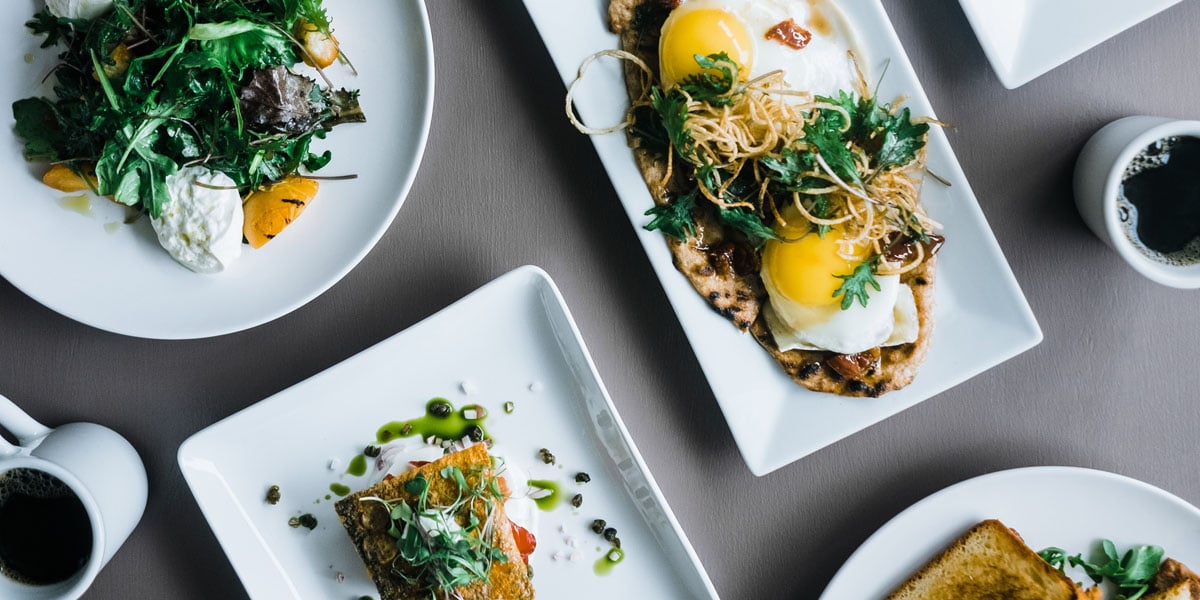
Ever heard the phrase “we eat with our eyes?”
That’s true in the social media world - and the reason why Instagram accounts like @BuzzfeedTasty are so popular!
People love to see photos and videos of food because we really do eat with our eyes. If something doesn’t look appealing, we won’t eat it - as studies, like the one by Science Daily, have proven.
In fact, Teddy Robinson, the Creative Director of London-based bar Grind, took this to the extreme and spent five years creating an ‘Instagrammable’ restaurant. He said:
“The most interesting thing is that people are just more aware than ever of what the food looks like.
Before Instagram, the only way you'd see what a restaurant's food looked like would be by looking at their own photos, or if they had them printed on menus - I know, the horror - but now it's often how you're introduced to a restaurant.
It's a refreshing change to see the food put front and centre like this, and it's definitely one of the things that has allowed independents to get a leg up on the chains on Instagram.”
Although you don't need to overhaul your entire decor, you'll need to factor the need for strong, branded visuals into your restaurant's social media strategy. Pairing high-quality images and videos with something unique for your brand will help you stand out and attract new visitors!
If you're struggling to create unique content, you could:
- Film how your chefs cook your most popular dish
- Create short tutorials for home-made cocktails
- Take a photo of your busy restaurant to give your followers FOMO (fear of missing out)
- Repost UGC (user-generated content), as it is great social proof (plus it encourages others to snap photos of your delicious meals)
- Include your brand's colours and unique details
- Introduce your audience to your local suppliers (today’s audience cares a lot about supporting local products and communities)
- Organise a social media takeover with an influencer
- Post carousels with reviews, affectionate comments, and stories behind your best selling dishes
Your social media posts aim to translate the restaurant's unique atmosphere and experience to the digital medium accessible by everyone.
Here's how Sweet Green promotes their local suppliers and dishes all in one post:
Fancy taking this a step further? Add User-Generated Content (UGC) into the mix by encouraging diners to snap their dish and share it on social media for you to repost.
Not only does that help give future visitors an unbiased view of your products, but it takes the pressure off creating visuals in-house.
Note: Make sure to tag the original user when posting UGC, and when working with influencers ensure to do a collaborative Instagram post. Also, remember that not all photos are a good match for your feed. If the image matches your brand guidelines - feel free to publish it as a post. If not - reposting to Instagram Story might be a better solution.
2. Use food-related hashtags in your posts
Hashtags help to raise awareness of your content on social media. Remember what I said about the number of restaurants you’re competing with?
That’s because hashtags make your content visible to people who wouldn’t otherwise view your content. Social media users can browse hashtags on X (Twitter), Facebook, and Instagram, and if you’re not incorporating some into your content, you could be missing out.
(This is especially true on Instagram, where users can follow hashtags - meaning your incredible visuals could show up on their feed without actually following you.)
Putting this into practice doesn’t take a ton of time, either. Follow these guidelines, and you won’t go far wrong:
- Up to 11 hashtags in Instagram posts (preferably in the comments section)
- 1-2 hashtags in your Tweets
- 1-2 hashtags in Facebook posts
- 6-10 hashtags in TikTok videos
You could test hashtags on LinkedIn too, but that depends on who you target. For example, a fancy lounge could target hiring managers who need a place to have a lunch meeting with the hashtag #LunchMeeting, but LinkedIn might not be the platform of choice for fast-food restaurants.
Take a look at how Pieology’s Instagram post uses captions to boost their reach:
Nandos do the same for their X (Twitter) feed by jumping onto trending hashtags and promoting their meals:
On the hunt to celebrate National Avocado Day? Smashing. #NationalAvocadoDay pic.twitter.com/f8pLk42TSG
— Nando's (@NandosUK) July 31, 2018
Not sure where to start in the hashtag world? Here are a handful of food-related hashtags to get you started:
- #Foodie
- #EatingfortheInsta
- #Foodgasm
- #ForkYeah
- #FoodLover
- #TasteThisNext
- #Yum
- #FoodPhotography
3. Boost Facebook posts to local people
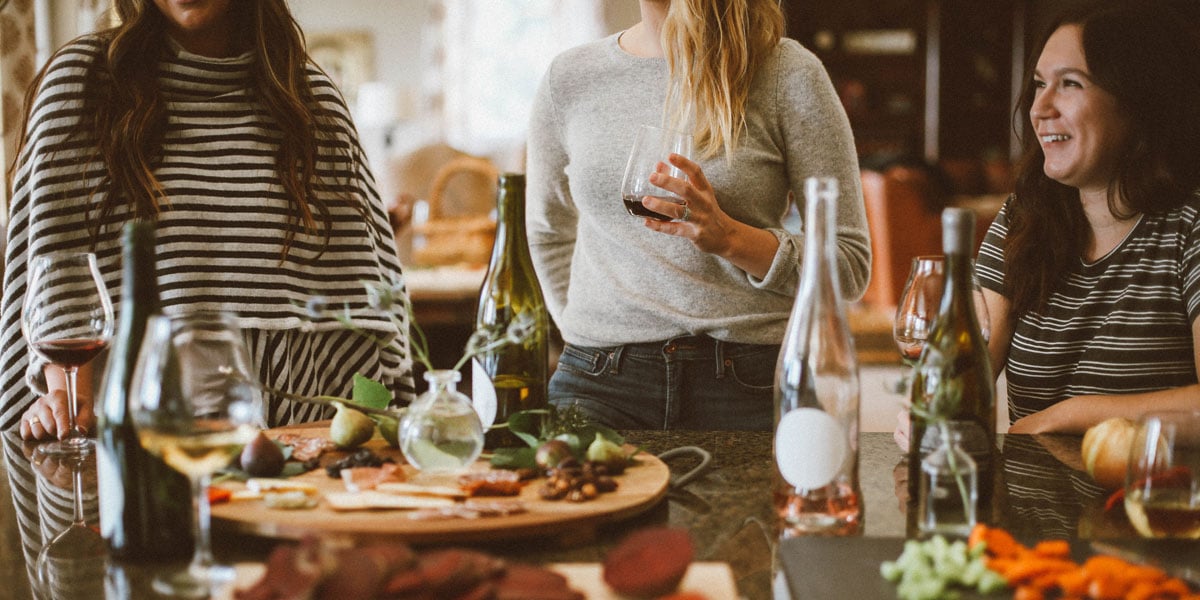
Organic growth is challenging; it's tricky to drive people to your restaurant with a single Instagram post. And, with platforms like Facebook following a "pay to play" motto, it might take a while for your social strategy to pay off.
But if you can't wait that long, why not play them at their own game?
Earlier, I mentioned how restaurants could use social media to target local customers and start advertising on Facebook from just a few dollars per day.
Suppose you've got the cash (and motivation) to combine the two. In that case, you could boost your Facebook posts and target people in your local area with the social content you've already created - making it a great way to maximise the results you get from a single piece of content.
To do this, post a regular post to your Facebook Page. Then, you will see a "Boost Post" button which looks like this:

The next page will take you to a section of Facebook’s Ad Manager, where you can set targeting preferences for your ad to attract the right audience.
It’s wise to cast the net wide and select anyone with an interest in food that lives within a 25-mile radius of your restaurant:
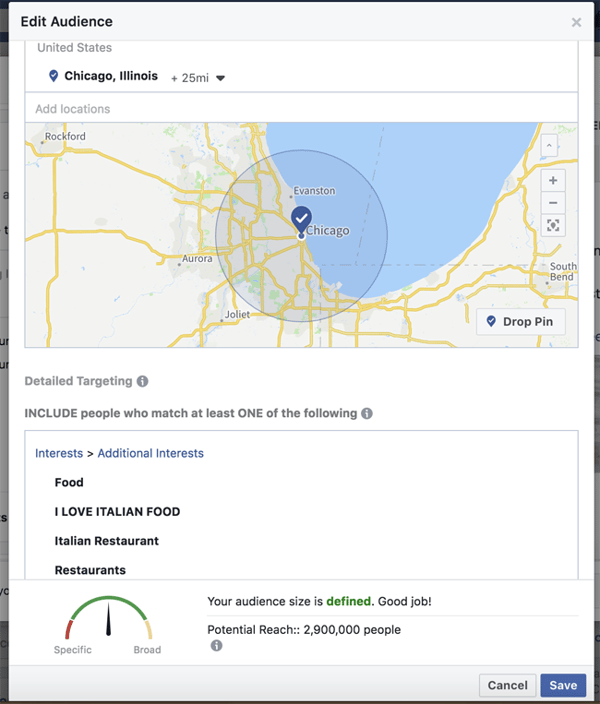
Dineout, an online catering restaurant, used this tactic to improve their restaurant’s social media strategy.
The result? A 3x return on their ad spend, 6x increase in bookings, and a 5x overall growth in their diner base.
Papa Murphy’s also used Facebook ads to share a coupon with their target audience:
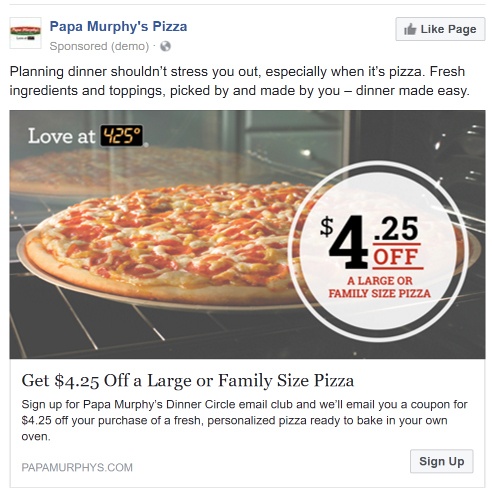
They generated a return on ad spend of over 3.5x, and 50% of people who clicked the ad signed up to their mailing list for future marketing.
Not bad for a bit of spare cash and time to experiment.
4. Run polls or competitions to get your audience engaged
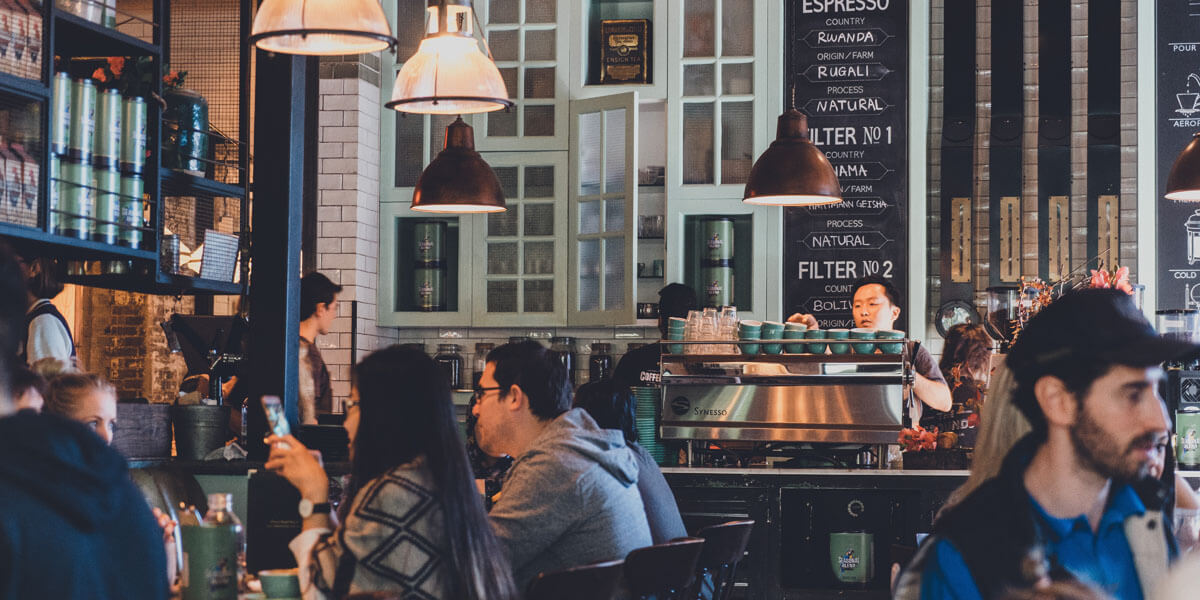
High engagement is the holy grail of social media.
Likes, shares, retweets and comments all prove your audience are invested enough to make a positive action - and studies show that engagement impacts conversions.
You can drive high engagement by using interactive content, such as quizzes or polls - something that 79% of marketers agree has reusable value, resulting in repeat visitors and several exposures.
For example, you could:
- Post a X (Twitter) poll and ask people to vote for your next dish.
- Run a competition and ask people to create their own meal, with the winner being featured on your menu.
- Ask your followers to vote for which topping they’d prefer on a dessert through your Instagram Stories.
Take a look at how Applebee’s use X (Twitter) polls to get their audience engaged:
There are countless ways to enjoy french fries, which means there are countless
— Applebee's Grill + Bar (@Applebees) July 13, 2018
ways to celebrate #NationalFrenchFryDay! What will you be doing?
Almost 430 votes isn’t bad, right? And, because X (Twitter) polls allow your audience to get involved by pressing one button to share their opinion, you’re already more likely to grab their attention in a crowded feed.
Piada Italian Street Food took their content a step further by challenging their audience to eat hot chicken carbonara - the hottest entrée on their menu:
The contest idea is excellent, but what's even better is the restaurant's attempt to jump on the engagement bandwagon. Following their page and tagging a friend meant they could also win the limited edition Hot Chicken CarbonaraT-shirt and two free entrées. It sounds like a good deal for a new potential customer, right?
That's a fantastic way to ensure your restaurant's social media accounts benefit from your contest!
Warning: While running contests helps to boost your following and overall engagement rates, be wary about how many you’re posting. Too many contests over a short period could come across as desperate and take the fun away from your competition, so stick to a handful each year.
5. Make it easy to view your menu and book a table
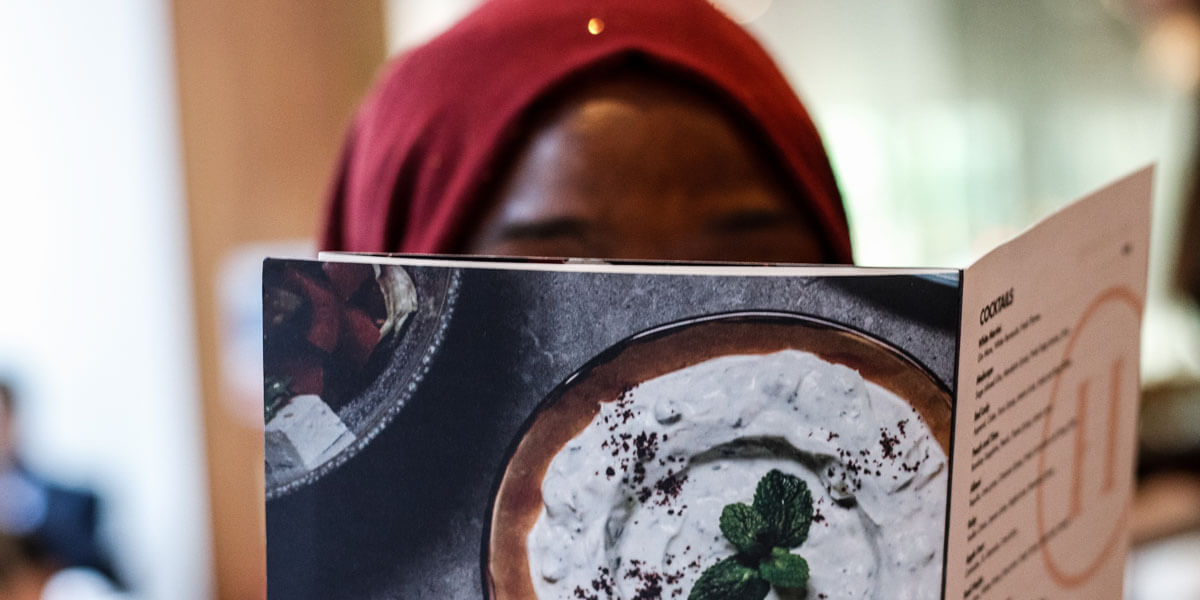
If people like what they see on your restaurant’s social media pages, they’ll want to visit.
But if you don’t have clear, understandable steps for them to take before booking (such as viewing your menu), you could be turning them away without even realising it.
You can make this easy for future diners by including a link to your table reservation or menus from your social media profiles, like this example on Red Lobster's Facebook Page:
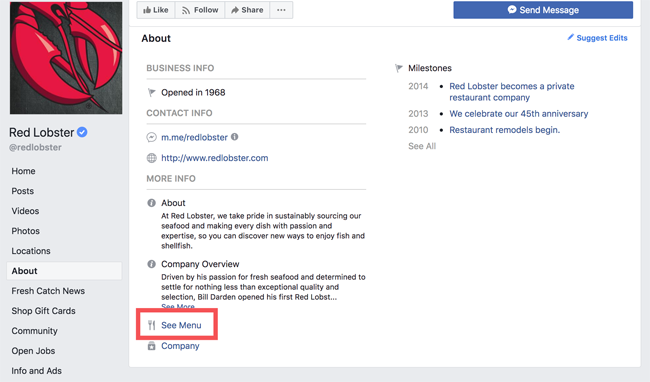
You should also make sure other sections of your profiles are accurately filled-in, such as:
- Contact numbers
- Email addresses
- Location addresses
Why?
The answer is simple.
Along with making your profiles look more cohesive, you’ll target people who’re actively looking to contact a restaurant or make a reservation on their latest search.
That’s the goal, right?
6. Give incentives for visitors to leave a review

Earlier, I mentioned how people eat with their eyes.
That’s true - but we also eat with our ears. And by ears, I mean listening to what other diners say about your food, and decide whether to pay a visit to your restaurant based on their opinion.
It goes without saying that you’ll need to collect tons of positive customer reviews to convince them. Your Google My Business and directory listings should be full to the brim with glowing testimonials to do that!
Here’s a listing for the Chicago branch of Wendy’s:
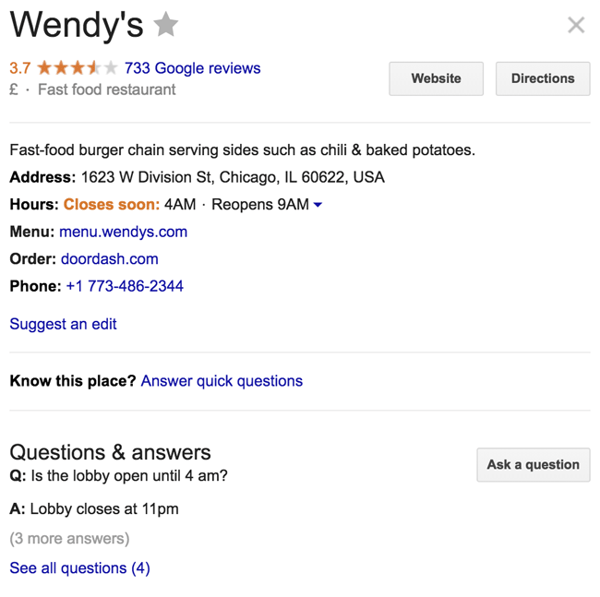
To save time, you can schedule posts to your Google My Business page, asking past customers to leave a review. You could even give incentives for this - such as discount codes, money off future meals, or free desserts.
But, with Instagram overtaking TripAdvisor for restaurant reviews, copying and pasting your customer reviews onto your social media profiles could be an effective way to get the most out of them.
I always check for social media reviews before visiting a restaurant.
In fact, I visited Krakow in Poland recently and headed to Pizzatopia purely because of the glowing reviews they have on their Facebook Page:
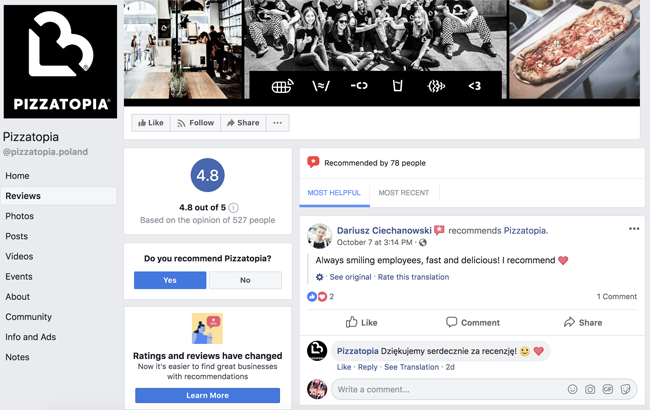
If it didn’t have those reviews, I wouldn’t have visited.
And I’ll bet you could be missing out on customers like me at your restaurant, too.
You should also focus on collecting reviews on restaurant browsing sites like TripAdvisor, Zomato and Zagat. These sites are visited by both local people and tourists, giving you an extra boost of awareness if you’re able to crop-up on the top-rated restaurant list for your city:
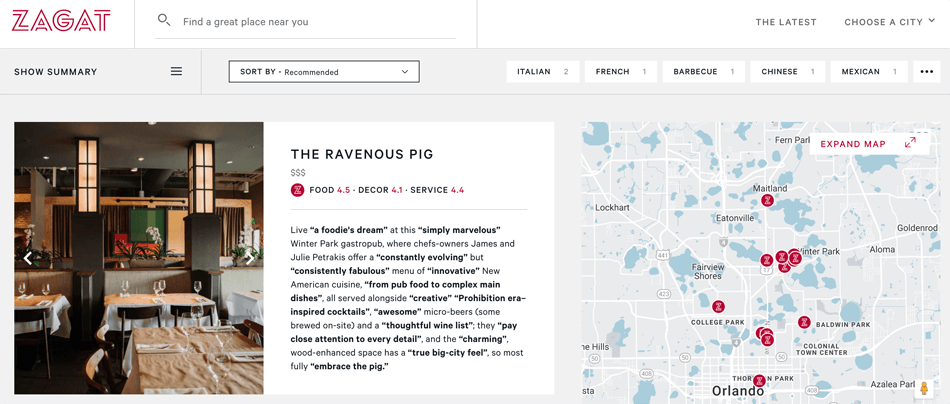
Which social media platform should you use for your restaurant?
Choosing the right social media platform is never an easy task. But if you want your marketing to work, you need to find the right channel to focus your efforts.
Ask yourself these questions:
- Where does my target audience spend time? Maybe they are too young to be on Facebook, and they prefer using Instagram and TikTok.
- What channel is aligned with my brand? If your restaurant is very posh, Facebook, Instagram, and Pinterest should be on the top of your list. If it's engaged in social causes, you might want to be more active on X (Twitter). Finally, if you're all about experimenting and setting trends, TikTok should be your go-to channel.
- Can I present my restaurant better through videos or images? Once again, Facebook, Instagram, and Pinterest are perfect for images! But, if you want to experiment with short-format videos, your choice should be between TikTok and Instagram.
Once you have an answer to these three questions, you can determine your primary social media platform.
Final thoughts on using social media for restaurants
Now you’re fully in the know about using social media for your restaurant business effectively, it’s time to get to work!
Remember to show off your delicious dishes, take advantage of the content your diners are already creating, and make it easy for people to make a table reservation (whether that’s through your online booking system or making a phone call).
Social media isn’t an easy nut to crack - but the long-term results make it worth your while.
Especially when you’re flooded with new happy diners!







![10 Valentine's Day Social Media Marketing Campaign Ideas [2024]](https://2235233.fs1.hubspotusercontent-na1.net/hub/2235233/hubfs/blog-import/2023/12-23-Dec/ideas-to-celebrate-valentines-day-on-social-media-header-image.png?width=80&name=ideas-to-celebrate-valentines-day-on-social-media-header-image.png)